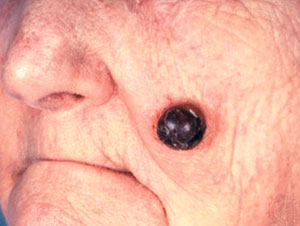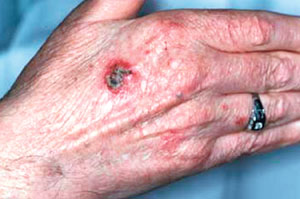Contrary to everything you’ve heard in the fairness cream advertisements it can be an advantage to be dark skinned. It’s the reason why skin cancer is very common in the west, where ultraviolet rays from the sun wreak havoc with fair skins. In Sri Lanka, the incidence is very much less, says Dr. K. Satgurunathan, Consultant Dermatologist. For those who do develop the cancer though, early detection and treatment is essential. The good news though, is that it’s easy to spot skin cancer, much easier than tracking those hidden in the abdomen or breast for instance. Once detected, a high percentage of cases are successfully treated, says Dr. Satgurunathan. The trick is to know when to go to a doctor.
Three common skin cancers
Your skin is your largest organ. It is beautifully layered: the epidermis is the outermost with the dermis just underneath. It is in the epidermis that you can find the cells known as keratinocytes, with melanocyts (pigment producing cells) in the basal layer. A layer made up of these protects the skin and the underlying tissue from heat, UV radiation and water loss. Below that, nestled in the dermis, lie the hair follicles, sweat glands, sebaceous glands, apocrine glands, lymphatic vessels and blood vessels. Cancer can arise in any of these, but commonly from keratinocytes and melanocytes reveals Dr. Satgurunathan.
 |
| Malignant melanoma |
Listing three principal types of skin cancer, he says that each have different symptoms and appearances. The most common is basal cell carcinoma (BCC). The main predisposing factor of basal cell carcinoma is exposure to ultraviolet light, with fair skinned individuals who work outdoors being most at risk. A slow growing cancer, it doesn’t usually spread to other parts of the body. Arsenic is linked to BCC. In Sri Lanka, BCC cases appeared in the late eighties thanks to arsenic poisoning. The arsenic had been ingested as a component of adulterated opium, explains Dr. Satgurunathan, adding that some have been linked to ayurvedic medicines that include arsenic as an ingredient.
BCC is most commonly seen on areas of the body that have been exposed to the sun such as the face, ears, scalp, shoulders and back says Dr. Satgurunathan. There are several subtypes of BCC but the most common manifestation is that of a small painless lump, pink/brownish-grey in colour, with a smooth surface with blood vessels and a waxy or pearl-like border. The lump grows, developing a central depression with rolled edges. It can also develop as a slowly expanding, ill defined, white, scar-like plaque with less of a tendency to ulcerate.
The second type, involving another type of cell in the top layer, is called squamous cell carcinoma, (SCC) and again is not known for its aggression. SCC is the second most common skin cancer and like BCC is known to affect in the sun exposed areas. However, it differs in that the main symptom is an area of thickened, scaly skin that develops into a painless, hard lump, reddish brown in colour with an irregular edge. The lump can becomes a recurring ulcer that doesn’t heal and the cancer has the potential to metastasize, i.e. spread from one part of the body to another, moving on to the lymph nodes and other organs.
While exposure to UV light and arsenic poisoning have been known to cause SCC it has also been linked to chronic wounds (such as long standing leg ulcers and burns), human papillomavirus infection (particularly in genital areas with genital warts), exposure to industrial carcinogens such as tars and mineral oils, and in cases where organ transplant patients have been treated with immunosuppression agents. Exposure to heat radiation has also been known to trigger SCC says Dr. Satgurunathan, explaining that women cooking over open fires would develop patches of affected skin on their shins, that being the part most exposed to the radiation from the fire.
 |
| Squamous cell
carcinoma |
The third is the most dangerous. Though most forms of skin cancer are easy to treat and pose only a small threat, malignant melanoma is difficult to treat unless detected early, says Dr. Satgurunathan. It can occur anywhere on the body, spreading rapidly through the blood into the liver, lungs or brain. It looks like the common mole but is a quick-growing, irregular, dark-coloured spot on previously normal skin or in an existing mole that changes size, colour, develops irregular edges, bleeds, itches, crusts or reddens. If an adult has a growing, changing, brown or black mark which cannot be covered by the blunt end of a pencil, this should be shown to the doctor straight away.
Occasionally, melanoma skin cancer can result in a swollen lymph gland. It also appears in places like the sole of the foot, mouth or eye, cautions Dr. Satgurunathan. Several risk factors have been identified. Again ultraviolet radiation, particularly intense, intermittent, burning exposures during childhood, multiple pigmented naevi (moles), fair skin type and having a first degree relative with melanoma have been listed. Approximately, half of melanomas develop in pre-existing moles.
In addition, a pigmented line in a nail is usually benign but can be a sign of a malignant melanoma, cautions Dr. Satgurunathan, pointing to one on his own nail. If the mark continues past the edges of the nail and onto the skin that borders it, it must be shown to a doctor, he emphasises.
It’s worth noting here that smoking tobacco can double the risk of skin cancer.
Treating skin cancer:
Doctors often opt to do a biopsy, removing a part or all of the suspicious growth/patch to determine what sort of cancer it is, and if it is malignant or benign. If melanoma is diagnosed, then your doctor is likely to ask you to undertake tests to help determine if the cancer has spread to other parts of the body. This may involve taking x-rays and scans to look at the liver, brain and lungs.
Treatment for non-melanoma skin cancers is almost always curative,if detected early says Dr. Satgurunathan, explaining that ‘excisions’ where the affected area is simply removed under surgery tend to solve the problem. Another method used on smaller cancers is cryosurgery, in which liquid nitrogen is applied to the tumour to freeze it and kill the cells. After being frozen like this, they simply shrivel and drop off once warmed up again.
Surgery is also the best option for melanoma, but its success is directly related to the depth of tumour invasion which is known as the ‘Breslow thickness'. Unfortunately, there is no effective treatment for metastatic melanoma – combinations of therapy that include chemotherapy, vaccinations and immunotherapy are used mostly on a clinical trial basis.
If treatment is successful – and in many cases it is – doctors will nevertheless track a patient’s progress for a few years to ensure that there is no resurgence in the cancer.
Checklist for suspected malignant melanomas:
Major signs
- If an existing mole gets larger or a new one is growing.
- If the mole has an irregular outline.
- If the colours are mixes--shades of brown or black instead of one even tone.
Minor signs
- If the mole is bigger than the blunt end of a pencil.
- If it is inflamed or has a reddish edge.
- If it is bleeding, oozing or crusting.
- If it starts to feel different: for example itching or painful.
- If a line of discolouration on the nail extends onto the skin.
|



